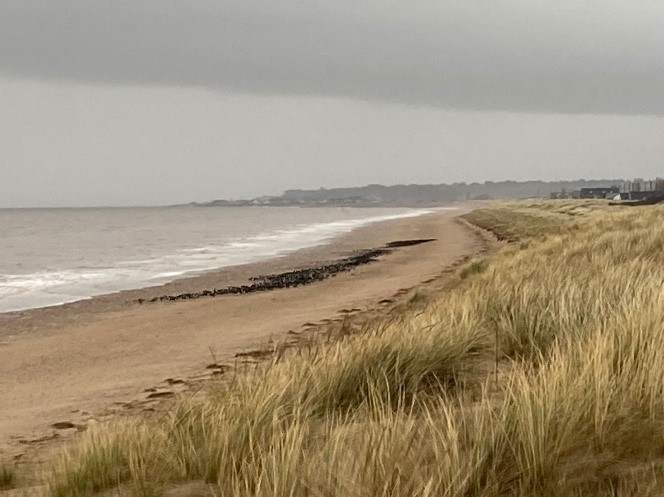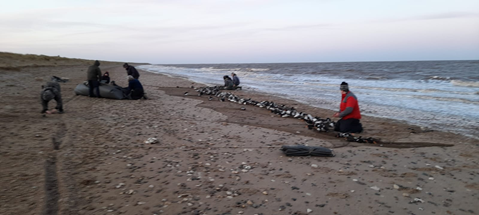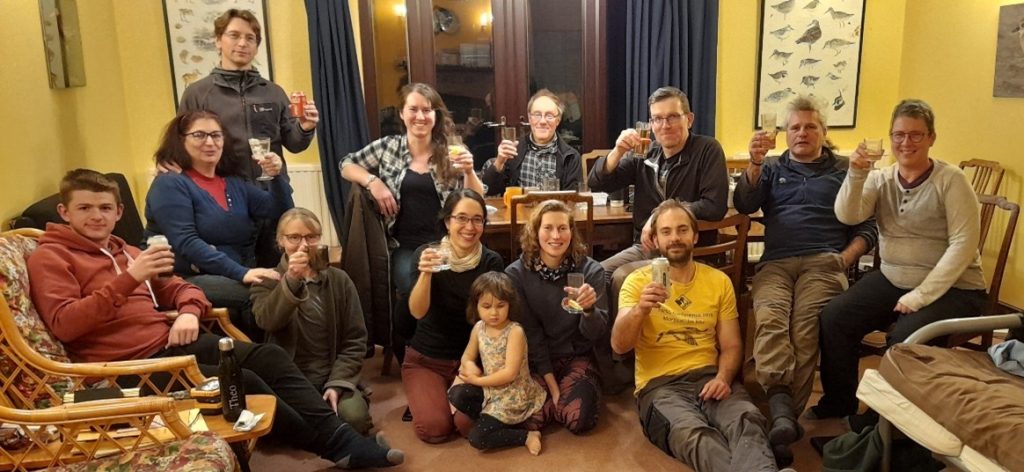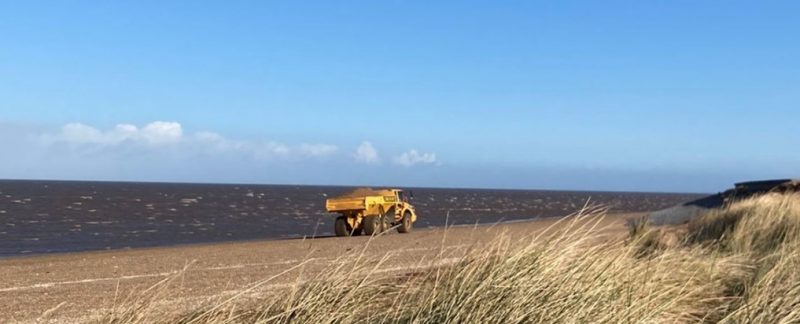Thursday 17 February
In anticipation of the coming Storm Eunice, Kirsty arrived at the base late afternoon, opened up and replaced the dripping tap glands. Lizzie and Ryan arrived later in the evening after collecting keys from Cathy. Plans were made for recces in the morning, provided it did not look too windy.
Friday 18 February
Ryan recced Heacham from the north, Lizzie and Kirsty starting at Snettisham (thankfully with the wind to their backs). A small catchable flock of c. 200 Oystercatchers was on Snettisham beach south of the Dam. Heacham beach had several small flocks of Oystercatchers and a large mass of greyish black in the centre. The weather was fairly inclement at this point, and Ryan, despite being on the beach, was unable to see the birds due to driving rain/hail into his face. Lizzie and Kirsty snuck up on the flock and identified it as over 2,000 birds, mostly Oystercatchers but with a few clumps of Bar-tailed Godwits, centred on the Tump on Heacham South. They were totally undisturbed, no-one else in sight. Having confirmed location, Ryan waited at Heacham with a lovely small mixed flock of waders at the groyne, Lizzie and Kirsty retreated to the Dam and waited for the mud to clear (along with the front of the storm clearing and leaving a beautiful, if very windy, morning), being rather surprised when, just as the water went off, a bulldozer and dumper trucks started moving north. They were moving material from south of the main car park to north of the Dam as part of an EA beach recharge. The birds were not really bothered by their movements.

A shop was done on the way back to the base, where Ryan set about cooking what was to be a big pie, and Lizzie and Kirsty sorted out cartridges. The wind was fair blowing, but all was well till 2 pm when we lost power. Thankfully the gas cooker still works if the electrics go off, so cooking was not interrupted. As team members arrived, kit was sorted in the garage, three net sets prepared for later and processing kit loaded into the large trailer for the morning.
Most of the team arrived by dinner at around 6.45 pm – power came back on at 6:10 pm so there was a mad flurry to cook the pasty for the now (yummily reduced) stew, and a hearty meal was eaten by all – so hearty was it, that only a dent was made on the cheesecake that Alex brought. Unfortunately, several team members had to drop out on the Friday as the storm stopped them from travelling.
A briefing was held and introductions made, before the entire team set off at 8:30 pm to set nets. Three narrow–full, large-mesh nets were set on a very windy Heacham South beach and the team were back to the base around 11:30 pm, some for hot chocolates laced with Bailey’s…
Saturday 19 February
The whole team was up at 5:15 am and on site at 06:20 am. Lizzie and Nigel were in the firing position – which they had to change at the last minute as there were even more birds on the beach, some roosting where they’d intended to call the catch from. Ryan and Kirsty long-stopped and Guy ran base camp. Net 3 (southernmost) wouldn’t test – we found out later that the dropper had been pulled out on three of the cannons and dragged to the dunes. Surely this can’t have been malicious as we were on the beach until 11 pm and back at dawn, but there were many sets of footprints in the dunes – deer, hares, rabbits, fox so it could have been from a mammal. We did not know this until later, but it was of no consequence – the birds were in Net 1 and (if we’d had one) Net 0. The remaining nets tested fine and Lizzie informed base camp it would be about 10 minutes – base camp didn’t even have time to go to sleep before the instruction to arm the box was given and Net 1 was fired by Lizzie at 07:05 am. The team was prepared for a wet catch, but it was only the very front edge that went in the water.

The birds were densely packed in a narrow band the whole length of the net, so it was quite complicated, but the team safely lifted them onto two large grey pieces of covering, which could then be pulled up the beach. Extraction took the next 80 minutes with over 300 birds in large-mesh nets – we so often use small-mesh nets now and this was a reminder of how easy it is to extract from them. Sadly, we couldn’t use small mesh nets with the wind, as they would not have gone out well. Cages were erected by Cathy and Ryan, aided by Theo, and quickly started filling, it soon becoming evident that we’d need at least six cages. Michelle and Nicholas joined us as we were extracting.
Lizzie set up a processing team of Nigel, Rob R, Michelle and David, with Rob P scribing, and Guy ran the ringing team. We were aiming to process a random sample of around 50 new birds and all the retraps, so eventually a second ringing team (Alex and Ryan) was set up. Ringing was made so much more efficient by Cathy, who looked after the keeping cages and passed birds to the ringers. Cathy and Ryan also colour-marked the one Bar-tailed Godwit we caught. We had one Oystercatcher with white feathering round the back of its neck – photos were taken, and a Norwegian control. The high number of retraps was notable and is likely to be because the flock was so undisturbed before the catch (no people on the beach and no twinkling), so all the experienced birds were caught.
It was a very pleasant, if windy, morning, and there were lots of passers-by, so lots of good opportunities for public engagement. This culminated in a group of about 15 adults and children towards the end of processing, who enjoyed very much the spectacle of the birds being released on the beach. Last bird released four hours after firing. Nigel left for home to assess storm damage and help Jacquie deal with power cuts.
| Species | New | Retrap | Total |
| Oystercatcher | 255 | 91 | 346 |
| Bar-tailed Godwit | 1 | 0 | 1 |
| Total | 256 | 91 | 347 |
Processing was all carried out in the dry, the rain just started as we left site for a very welcome full breakfast back at the base cooked by Kirsty and Alex with Ryan assisting, whilst the rest of the team sorted out the equipment.
The forecast looked terrible for the evenings so both mist-netting sessions were cancelled early, and instead plans made for resighting, both on Saturday afternoon and Sunday morning, and a sociable meal planned for the evening. It was a blessing not having a wet net to deal with as it was raining again by this point.
Resighting was stoically carried out by Ryan and Ian (no birds seen) and Rob P and Theo (no birds seen) – it was pouring with rain by this point. The rest of the team shopped (Alex and Lizzie), cooked (Alex and Cathy), did the catch data (Kirsty and Nicholas) and input moults from old ringing books (Rob R, Guy, Michelle and Sam, who joined us with Skye because they had no power at home after the storm). Rob checked some of the retraps including a bird that had first been caught in 1990, age 8, so was at least 32 years old – older than many of the team!
Dinner was a scrummy chorizo pasta, followed by more cake, and after we’d had our fill Rob R had us charge our glasses in order to raise them in memory of Mike Watson, who sadly died two weeks before this trip. Mike had been coming to WWRG since the early days, and although not a ringer was a stalwart on the catering and support side (recceing and scribing) and has during his time looked after so many aspects of trips (and trip attendees). He has touched the lives of many of the group, and will be much missed. We took a group photo and sent our tribute to his wife Daphne, who was very touched by the support of the WWRG family.

Sunday 20 February
Up at 6:15 am for resighting. Thankfully a dry morning by the time we left, but the wind was still wild.
Resighting info as follows:
Theo and Alex – Snettisham Pits (no marked birds seen)
Rob R and Lizzie – Snettisham / Ken Hill fields (14 Curlew seen, two of which were flagged)
Kirsty & Guy – Heacham NN (150 Oystercatchers, one colour-ringed; 20 Turnstone, eight colour-ringed) Heacham N (20 Turnstone, five colour-ringed) and round Sedgeford (six Curlew, including two flagged birds) plus four Curlew in field opposite the Lavender centre, one flagged.
Cathy, Sam & Skye – Inglethorpe & Heacham fields (140 curlew, six flags seen one of which was a tagged bird)
Ryan & Ian – Dersingham Fields (four Curlew, no marked birds seen)
Colour mark resighting totals:
| Species | Total Sightings | Individuals | WWRG | Non-WWRG |
| Curlew | 9 (11 but 2 flags not read) | 9 | 9 | 0 |
| Oystercatcher | 1 | 1 | 1 | 0 |
| Turnstone | 13 | 13 | 13 | 0 |
| Total | 23 | 23 | 23 | 0 |
Note: the colour marked Oystercatcher is one we had removed a tracker from previously.
By the time the team had all returned to the base, Lizzie and Alex had cooked a delicious breakfast, Ian had left to try to get back home and Ryan had checked the dropper and cartridges from Net 3 of the previous day and fixed a strange sound on Sam’s car. Fuelled by breakfast, a team scraped up the carpet of dead moss in the driveway, Rob R transcribed the ‘ring and fling’ totals onto data sheets and we cleaned, packed up and shut up the house.
A big thanks to everyone involved for making this a successful and enjoyable weekend.
Trip report written by Kirsty Turner

